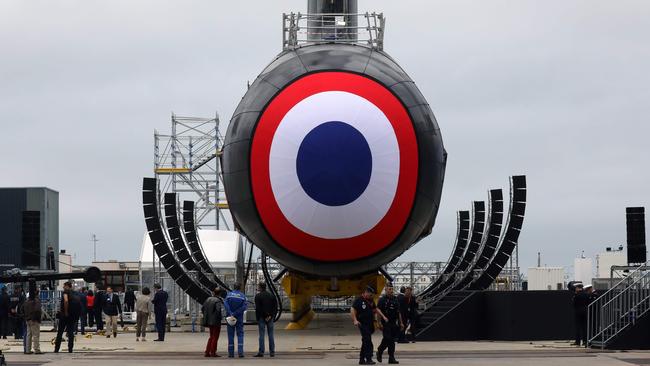Australia needs these submarines — how late will they be?

The decision to acquire 12 long-range submarines was first made by the Rudd Labor government. In a world characterised by uncertainty this is a vital acquisition for our nation.
Submarines have capabilities unlike any other platform. They project Australian defence in a unique way. They are one of the most strategic assets Australia has. And this is the most expensive Defence acquisition in our nation’s history.
Labor totally supports the Future Submarine Program and Australia cannot afford to see it fail in any way.
Yet the ANAO report is deeply concerning.
The ANAO has found that the project’s design phase is already nine months behind. This comes on top of the Senate estimates revelation that construction of the first future submarine has been pushed back a year.
The Abbott-Turnbull-Morrison government’s original timeline was based on the need to have the future submarines operational in the mid-2020s. Now the first of them will not be operational until the mid-2030s.
The program has slipped back 10 years in the past six.
Against this background the ANAO report states that Defence’s own analysis is that a delay in the Future Submarine Program of more than three years will create a gap in our submarine capability.
As a result, the Collins-class will now likely have to be extended into the 2040s, putting a greater buredn on the Australian Submarine Corporation as the critical enabler for maintaining and sustaining the Collins-class.
Yet the ANAO found that planning to extend the life of the Collins-class to cover any gap is only at an early stage, despite the fact the first of the Collins-class boats will otherwise become due for retirement from 2026.
Meanwhile, the government is allowing the workforce at ASC to atrophy, with attrition among ASC engineers alarmingly running at more than 10 per cent a year.
The government’s delay in making a decision on the location of full-cycle docking work for the Collins-class — which Defence Minister Linda Reynolds said would be announced before the end of last year — is only adding to the uncertainty for ASC’s workforce.
At Senate estimates it was revealed that the future submarines would cost taxpayers about $80bn to acquire and $145bn to sustain.
Now the ANAO report reveals that Defence is unable to demonstrate that expenditure of the first $400m has been fully effective.
The ANAO report also states that fabrication of some hull parts for the first future submarine will be offshored to France by the government to meet timelines.
This is a complete breach of faith of the Australian defence industry, particularly in South Australia. It is the realisation of our worst fears for the level of Australian industry content in the Future Submarine Program.
Time and again this government has proclaimed that the future submarines will be built in Australia. Yet from the initial claims that 90 per cent of the project would be Australian-built, the government has crabwalked away from its commitment to the local defence industry.
We know the government failed to secure guarantees on local content and Australian jobs in its negotiations with the French Naval Group.
It now appears that despite all the press releases and hoopla, the result is the sacrifice of Australian jobs.
In rushing the acquisition process, to a sole bidder, the government greatly reduced Australia’s bargaining power in this process. This alone was a mistake of epic proportions that is now coming home to roost for the Abbott-Turnbull-Morrison government.
Perhaps of most concern is the extraordinary revelation in the report that the chairman of the government’s Naval Shipbuilding Advisory Board, former US Navy secretary Don Winter, “warned in September 2018 that Defence should assess whether program risks outweighed the benefits of proceeding”. This is breathtaking.
Given that the ANAO has previously said the naval shipbuilding program involves “high to extreme risk”, this is a moment when every Australian concerned about the defence of our nation should be aghast at how the Future Submarine Program is being managed by this government.
Yet, with all of these red flags, where is the minister?
Surely, the Defence Minister, and indeed the Prime Minister, must front up and explain to the nation what is happening with this vital project.
Instead Scott Morrison and Reynolds are completely missing in action. This is gross negligence in the face of the most serious duty.
The stark reality is that on every key metric — timeframe, cost and local content — the numbers are all heading the wrong way.
The details around Australia’s Future Submarine Program do require a degree of opaqueness. But this cannot be an excuse for the government failing to provide the public with an assurance and confidence that the program is on track. And if it is not, then the government must come clean.
Australian taxpayers should not have to rely on ANAO reports and Senate estimates testimony to know what is happening with their vital submarines. It is well past time for Morrison and Reynolds to stump up and provide an honest account of Australia’s Future Submarine Program.
Richard Marles is Deputy Leader of the Australian Labor Party and opposition defence spokesman.


The warning bells over the federal government’s Future Submarine Program hit an alarming level with this week’s scathing Australian National Audit Office report, which reveals the project is beset by deep uncertainty, risk and delivery delays.